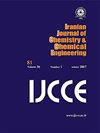Study of the Effect of Poly(ethylene glycol) on the Nifedipine Microencapsulation and Release
IF 1
4区 工程技术
Q4 CHEMISTRY, MULTIDISCIPLINARY
Iranian Journal of Chemistry & Chemical Engineering-international English Edition
Pub Date : 2021-10-27
DOI:10.30492/IJCCE.2021.528708.4684
引用次数: 0
Abstract
Nifedipine is a dihydropyridine derivate calcium channel blocker, suitable as first-line therapy for patients with hypertension. When blood pressure is high, nifedipine will prevent calcium to pass into cardiac and vascular smooth muscle cells. Nonetheless, nifedipine has a low elimination half-life that makes nifedipine needs to be consumed repeatedly to enhance its bioavailability, and thus, gives rise to nifedipine concentration in blood. Hence, a controlled drug delivery system is needed wherein the drug could be delivered at the desired time. One of the options in drug delivery is drug microencapsulation using a polymer as a coating material. In this study, nifedipine was coated with poly(D-L lactic acid) (PDLLA)/poly(ethylene glycol) (PEG) polyblend also polycaprolactone (PCL)/PEG polyblend using solvent evaporation technique. The effect of the mass composition of the polyblend and molecular weight of PEG on the encapsulation efficiency and drug release was investigated. Microcapsules with the variation of PDLLA/PEG and PCL/PEG composition and PEG molecular weight had encapsulation efficiency of about 90%-92%. Microcapsules with PDLLA/PEG600 (9/1) exhibited the highest drug release of 43.2% with an encapsulation efficiency of 91.96% whereas microcapsules with PCL/PEG400 (7/3) had the highest drug release of 44% with an encapsulation efficiency of 90.64%.聚乙二醇对硝苯地平微胶囊化及释放的影响
硝苯地平是一种二氢吡啶类钙通道阻滞剂,适合作为高血压患者的一线治疗药物。当血压高时,硝苯地平会阻止钙进入心脏和血管平滑肌细胞。尽管如此,硝苯地平的消除半衰期较低,因此需要反复服用硝苯地平以提高其生物利用度,从而导致血液中硝苯地平浓度升高。因此,需要一种受控的药物递送系统,其中药物可以在所需的时间递送。药物递送的一种选择是使用聚合物作为涂层材料的药物微胶囊化。本研究采用溶剂蒸发技术将聚D-L乳酸(PDLLA)/聚乙二醇(PEG)共混物和聚己内酯(PCL)/聚乙二醇共混物包被硝苯地平。考察了聚乙二醇的质量组成和分子量对包封效率和药物释放的影响。不同PDLLA/PEG、PCL/PEG组成和PEG分子量的微胶囊包封率在90% ~ 92%之间。PDLLA/PEG600(9/1)微胶囊释药率最高,为43.2%,包封率为91.96%;PCL/PEG400(7/3)微胶囊释药率最高,为44%,包封率为90.64%。
本文章由计算机程序翻译,如有差异,请以英文原文为准。
求助全文
约1分钟内获得全文
求助全文
来源期刊

Iranian Journal of Chemistry & Chemical Engineering-international English Edition
CHEMISTRY, MULTIDISCIPLINARY-ENGINEERING, CHEMICAL
CiteScore
2.80
自引率
22.20%
发文量
0
审稿时长
6-12 weeks
期刊介绍:
The aim of the Iranian Journal of Chemistry and Chemical Engineering is to foster the growth of educational, scientific and Industrial Research activities among chemists and chemical engineers and to provide a medium for mutual communication and relations between Iranian academia and the industry on the one hand, and the world the scientific community on the other.
 求助内容:
求助内容: 应助结果提醒方式:
应助结果提醒方式:


